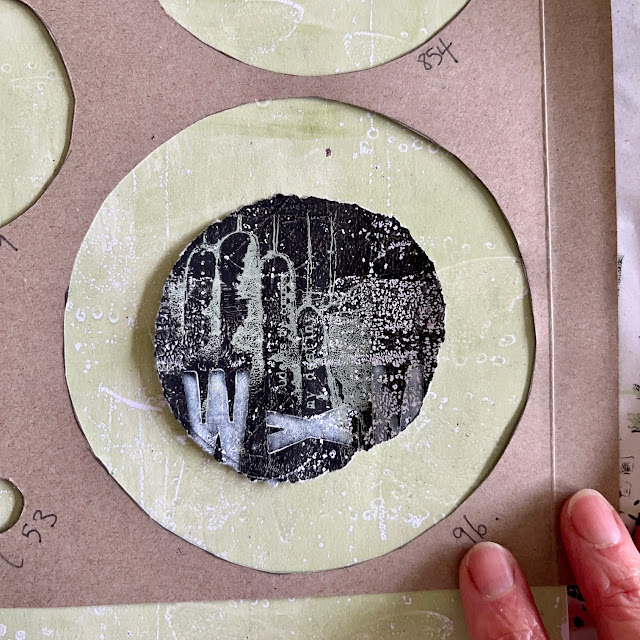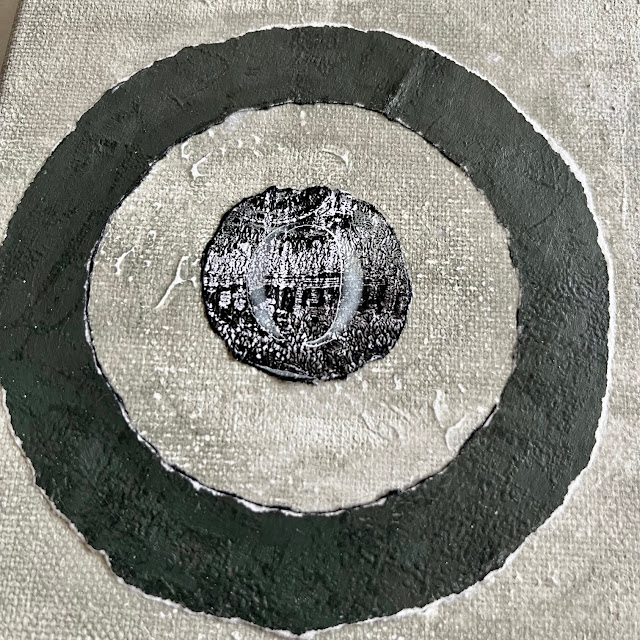Hi everyone,
It's Floss Nicholls aka flossWORKSHOPart here with you today.
I was pleased to be part of the final colour wheel monochromatic topic of the year because I have enjoyed contributing to them all so far; I feel that there's something quite meditative about mixing colours and I couldn't wait to get started.
This latest colour wheel had me thinking about being bold and creating something for a wall. I have a recent personal challenge for myself to make BIGGER art and what better excuse do I need to put 'bigger' into practice... I adore circles and monotone themes and so thought that making a large canvas to hang on my dining room wall would fit this challenge nicely.
I had originally planned to feature more typographic images and stitched lines but when I got down to the assembly I actually preferred to use the imagery in a more subtle way and make more of a feature of the tetradic colourway instead.
I was asked to use green within the monochrome colour wheel and so I chose one of my favourite greens; Tinned Peas, to go with Little Black Dress, Cloud 9 and the Everything Art rubber stamp sets shown below.
As with all the colour wheel projects that I have had the pleasure of sharing with you, I started by making a full colour wheel using three PaperArtsy fresco finish chalk paints. This time I used Little Black Dress FF19, Cloud 9 FF149 with Tinned Peas FF55
I really wanted to use a good contrast within my colour choice and so I chose to use the two strongest 'opposites' black and white. The cloud 9 is a softer slightly more creamy white which I thought might be good to define it from the white canvas background...but then I decided it'd be fun to have a textured background on the canvas too and so that idea went completely sideways. I automatically fell in love with the Cloud 9 as soon as I started painting a whole flat page of it. It reminded me of my favourite vanilla white embossing powder, so I made a mental note that I needed to add this to my next shopping list as I know it's going to become one of my go to paints!
Sorry...I digressed in a moment of colour bliss...back to my tedrads...with the great tip Dounia gave in one of her blogs, 'try not to use all the colours in the same quantity', I opted for a complementary TETRAD split as shown below. This combination uses two primaries with their two opposite secondary colours. I thought that this offered a harmony so that I could use strong variations for foreground and background pops of colour.
With the clear idea of wanting to use circles I started doodling layouts which could be fun on a big scale. I considered stitching in, around and through the circles, I considered adding asemic writing to embrace the typographic theme...
and then I thought before I go any further it'd be more useful to cut out some paper circles** and play with layouts rather than doodling them on paper to get a better feel of placement and size.
Rather than adding gesso to the whole canvas and stamping into that, I decided to add gesso to the stamp and stamp that onto the canvas. My thinking behind this was that I wanted to add a light 'broken' or textured wash over the canvas rather than keeping the blank stark white background. I also wanted the colour to absorb into the canvas in areas. I used PaperArtsy's Everything Art EEA02 hand and moth stamps for this as I loved the compass detail and the grungy details. I did two test runs on small canvas's to see whether I liked the outcome before I started on the 400mm x 400mm one. I videoed the small canvases to show the process... (scroll to the end to watch)
The gesso left most of the stamp detail on the canvas. TIP: put something firm beneath the canvas when stamping.
I then started looking at what textures to add to the whole pages of painted paper I had made. I used Wow matt clear embossing powder and Ranger Archival Ink in moss green here. I especially liked the two dark sheets but knew I had to get the gel plate out to get rid of the flatness of the pages...
I played around with my paper circles** and decided on the layout. (photo taken before I had used the gesso). I drew around various round objects I had in the workshop to get my sizes and was rough in cutting round them rather than being precise.
I don't know about you...but I am much more of a ripper than a cutter and wanted my circles to have a torn slightly uneven edge and not a 'perfect round smooth circle' hence the rough cutting. If this is not your thing then naturally feel free to use a compass and a pair of scissors for all circle making stages. I used scissors only at this stage for the shape to draw round to use once I had printed my papers.
Having torn paper many times I knew that if you tear it one way you show more of the unpainted edge and vice versa. The way to remind myself especially for circles was to tear two from a page in my scraps box...one clockwise circle and the other anticlockwise. I am right handed and so the paper in my right hand was torn upwards leaving more unpainted white edge on the clockwise tear...if you are left handed naturally the outcome for you is likely to be the other way round.
Using the same colours from my colour wheel I used my gel plate to create a selection of textured papers to use for my circles.
I also used the colours over ones I had already painted from the same colour wheel selection to bring me more depth and texture. I used the letters from Everything Art EEA05 that could be read either as is or in reverse on my stamping block so they read the correct way round regardless of whether I used them to texture the gel plate and pull a print or to take the paint off the gel plate and stamp it directly on a printed sheet. I like to press the stamp that I have pressed into the paint on the gel plate to make an imprint onto other prints to make full use of the paint so less gets wasted or washed down the sink.
I loved the subtle textures that I was creating with the stamps and in this case decided that it would be good to focus on the colours more than the powerful images as a focus.
The circles went back onto the canvas to relook at my position choice and then I numbered them so I knew where I'd placed them!
Using a piece of card to make the circles into windows allowed me to select the exact piece of printed paper I liked for a circle. I use this method quite a lot and it does go totally against my OCD of cutting paper near the edges to not get too much waste by cutting right in the middle of something, but textures and patterns here were far more important and I know the rest of the paper will definitely get used for other things!
I did this with each of the layers in all the circles and then moved them about again until I was happy with all nine.
I tore the circles and arranged them paying attention to contrast and harmony in my choices.
I do like how the colours and texture compliment each other and how the stamp designs are subtle rather than the focus of the piece. I used the bottom left circle as an O to also represent the typographic theme as well as part of the overall circle design.
I decided to edge finish a few with Ranger archival black ink and glued them onto the canvas using a gel mat medium.
I divided the canvas into 9 equal squares and positioned each circle within the centre of them. I found this to be the easiest way to place the circles as they were not of equal sizes.
My favourite colour is green and so the colours really appealed to me personally in this monochrome colour wheel topic. The canvas is now hanging in my dining room.
I use rubber stamps in many ways, for texturizing, for over stamping, for adding phrases or focal points to my art and this project made me reflect on the many ways I do that within my work and how calming art keeps me in my everyday. I found this project particularly calming as there was a lot of colour mixing and methodical repetition in the processes. I do hope that if you give this project a try, whether it's in a journal or on a canvas and whether you use the same stamps or colours I have, or not, it also brings you the same amount of joy and calm in the process as it did for me.
I have created a two minute video to show how I added the gesso texture stamp to the canvas. A little tip...with the canvas not being a solid surface, I found that a lot of the stamp did not imprint. By using a book or a solid surface beneath the canvas allowed a much better outcome.
Until next time,
Much love,
Floss x x x
website/in-person workshop bookings: flossWORKSHOPart
Facebook: floss.workshop.art
Instagram: floss_workshop.art
Full Day Mixed media in-person workshop:








































1 comment:
Such a fantastic piece of art, Floss! Love love love! x
Post a Comment